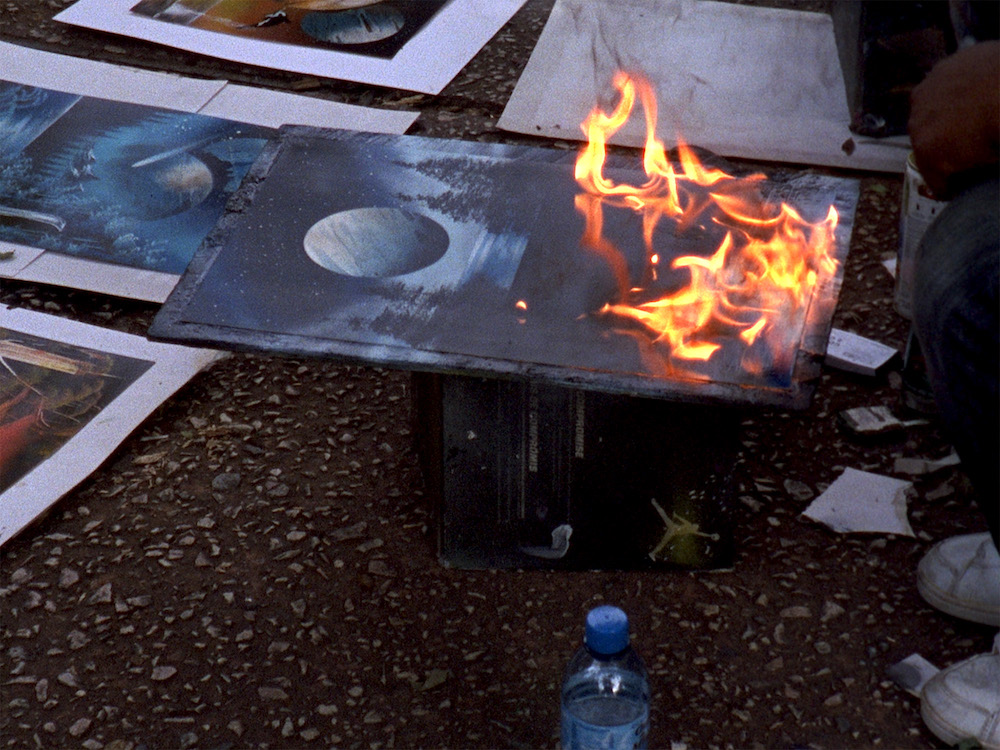“I’m not sure satisfaction is a thing I feel while making art. I get satisfied from stuff like getting my laundry done or digging a trench or putting away my books,” mused director Deborah Stratman in a recent interview with Documentary magazine. Perhaps this questing, open-ended relationship to her practice is why, at age 57, Stratman has nearly two dozen films to her name. An associate professor at the University of Illinois in Chicago, where she’s based, Stratman has exhibited work as far and wide as the Whitney Biennial, MoMA, Centre Pompidou, Hammer Museum, ICA London and pretty much every international film festival circuit. By some accounts, her video assemblages are the first to be described as “experimental documentary.”
Typically, Stratman directs, shoots, edits and designs the sounds for all her films, which eschew narrative conventions of causality or linearity in favor of the associative logic of a collagist. The gestation period for each production is unpredictable, sometimes lasting months, sometimes years, although “there’s a tipping point where if I were to keep collecting, a film loses momentum and I get bored,” as Stratman explained in a conversation about Last Things (2023), her latest documentary. “For essayistic films like this one, I accrue way more material than I can use. Then I condense that unruly, amorphous cloud to try to say as much as I can in as few moves as possible.”
The opening shot of Last Things is the earliest known rendering of the Milky Way, a drawing by astronomer William Herschel from 1785. It resembles an approaching figure, with our sun where the heart would be. “All the world began with a yes,” quotes the clear, softly accented voice of filmmaker Valérie Massadian, one of two that will echo in voiceover throughout Stratman’s “science factual” film. “One molecule said yes to another molecule and life was born,” Massadian continues, “but before prehistory there was the prehistory of prehistory.” This epoch is the focus of Last Things. A mesmerizing collage of video, images and quotation—this first line is from Clarice Lispector’s 1977 novel The Hour of the Star—Last Things radically decenters mammalian development from our narrative of the planet’s becoming. This is evolution from the geological perspective: 16-millimeter footage of wildly spiraling, propagating crystals, glowing stalactite caves, microbiological family trees and other ephemera from the mineral world conjure a fruitful planet in which humankind is a peripheral organization of matter.

Still from The Illinois Parables, 2016.
Some scientists have called the Anthropocene “the geologic turn,” since the planet is experiencing change on a scale not known in human history. Last Things, likewise, faces backwards and forwards, describing both the past and the possible post-human future. Stratman fuses together two stories by the 19th-century speculative fiction novelist J.-H. Rosny to form a narrative voiced by Massadian, in which inorganic alien life forms—the geometric Xipéhuz and the crystalline, iron-eating Ferromagnetics—have colonized Earth, laying waste to human society and leaving only a few unlucky survivors to bear witness to the new geological order.
The other voiceover in Last Things comes from geologist Dr. Marcia Bjornerud, partially from interviews recorded with Stratman, and partially from lectures given for a course known as HELL (the “History of Earth and Life”) at Lawrence University in Wisconsin. Acting as an ambassador from the geo-biosphere, Bjornerud advocates for a “poly-temporal” worldview that incorporates the overlapping rates of change that effect our planet, particularly those that are so powerful they mostly surpass the scale of human perception. Rocks, too, can adapt, evolve and go extinct, she explains; but their lifetimes are beyond anthropocentric comprehension.

Still from Last Things, 2023.
The enormity of planetary timescales, which render almost any form of life fleeting, carry a kind of inherent violence. For her part, Stratman has said that “low-grade terminal anxiety” about being in the midst of the sixth great extinction was the catalyst for making Last Things, which has been slowly migrating to independent theaters across the United States. Her filmography often contextualizes human activity within a topographical scope—in such films as O’er the Land (2009) and The Illinois Parables (2016), Stratman foregrounds the landscape as constructed by various ideologies but ultimately resistant to it; no matter how territory is divided or appropriated, human struggles play out upon an unfeeling terrain. Nobody talks about global warming in Last Things, but they don’t have to—extinction proves cyclical, change once again the rule.
I was able to catch a late-night screening of Last Things at a local theater on a special limited run. Afterwards, stepping into the night air outside the theater, I had the profound sense that I was just visiting. It’s a relief to leave behind the messy, fleshy human world for something more perfect and enduring.


